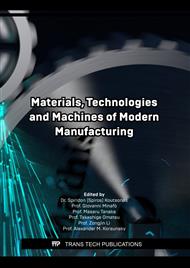[1]
Q. Zheng, B. Shi, Z. Li, ZL. Wang: Adv Sci Vol.4 (2017), p.1700029.
Google Scholar
[2]
H. Askari, A. Khajepour, MB. Khamesee, Z. Saadatnia, ZL. Wang: Nano Today Vol. 22 (2018), pp.10-13.
DOI: 10.1016/j.nantod.2018.08.001
Google Scholar
[3]
A. Jie, P. Chen, C. Li, F. Li, T. Jiang, Z.L. Wang: Nano Energy Vol.93 (2022), p.106884.
Google Scholar
[4]
C. Shengnan, L. Zhou, D. Liu, S. Li, L. Liu, S. Chen, Z. Zhao, W. Yuan, Z.L. Wang, J. Wang: Matter Vol.5 (2022), p.180–93.
Google Scholar
[5]
A. Matin Nazar, K.-J. I. Egbe, P. Jiao, and A. H. Alavi: Behavior and Mechanics of Multifunctional Materials XV Vol. 11589 (2021).
DOI: 10.1117/12.2581463
Google Scholar
[6]
K.-J. I. Egbe, A. Matin Nazar, P. Jiao, and A. H. Alavi: Active and Passive Smart Structures and Integrated Systems XV Vol. 11588 (2021).
DOI: 10.1117/12.2581669
Google Scholar
[7]
Y. Zeng, H. Xiang, N. Zheng, X. Cao, N. Wang, Z.L. Wang: Nano Energy Vol.91 (2022), p.106601.
Google Scholar
[8]
A. Matin Nazar, K.-J. I. Egbe, and P. Jiao: Energy Technology, (2022).
Google Scholar
[9]
H. Zheng, Y. Zi, X. He, H. Guo, YC. Lai, J. Wang, SL. Zhang, C. Wu, G. Cheng, ZL. Wang: ACS Appl Mater Interfaces Vol.10 (2018), pp.14708-14715.
DOI: 10.1021/acsami.8b01635
Google Scholar
[10]
G. Xin, J. Shao, M. Willatzen, Y. Yang, Z.L. Wang: Nano Energy Vol.92 (2022), p.106762.
Google Scholar
[11]
J. Ma, J. Zhu, P. Ma, Y. Jie, ZL. Wang, X. Cao: ACS Energy Lett Vol.5 (2020), p.3005–11.
Google Scholar
[12]
Y. Guo, XS. Zhang, Y. Wang, W. Gong, Q. Zhang, H. Wang, J. Brugger:Nano Energy Vol.48 (2018), pp.152-160.
Google Scholar
[13]
M. Zhu, Q. Shi, T. He, Z. Yi, Y. Ma, B. Yang, T. Chen, C. Lee: ACS Nano Vol.13 (2019), pp.1940-1952.
Google Scholar
[14]
B. O. Ayegba, K.-J. I. Egbe, A. M. Nazar, M. Huang, and M. A. Hariri-Ardebili: Energies vol. 15(3), (2022) p.1069.
Google Scholar
[15]
P. Jiao, K.-J. I. Egbe, Y. Xie, A. Matin Nazar, and A. H. Alavi: Sensors, Vol. 20(13) (2020) p.3730.
DOI: 10.3390/s20133730
Google Scholar
[16]
A. Matin Nazar, P. Jiao, Q. Zhang, K.-J. I. Egbe, and A. H. Alavi: IEEE Instrumentation and Measurement Magazine, Vol. 24(4) (2021), 49–58.
Google Scholar
[17]
H.Liu, K.-J. I. Egbe, H. Wang, A. Matin Nazar, P. Jiao, and R. Zhu: Materials Vol. 14(22) (2021), p.6882.
Google Scholar
[18]
P. Jiao, Y. Yang, K. I. Egbe, Z. He, and Y. Lin: ACS Omega, Vol 6(23) (2021), pp.15348-15360.
DOI: 10.1021/acsomega.1c01687
Google Scholar
[19]
K.-J. I.Egbe: International Journal of Engineering Research and Advanced Technology Vol. 05(02) (2019), p.67–79.
Google Scholar
[20]
A. Matin Nazar, K.-J. I. Egbe, P. Jiao, Y. Wang, and Y. Yang: APL Materials Vol. 9(9) (2021), p.091111.
DOI: 10.1063/5.0064300
Google Scholar
[21]
P.Jiao, A. Matin Nazar, K.-J. I. Egbe, K. Barri, and A. H. Alavi: Scientific Reports, Vol. 12(1) (2022).
DOI: 10.1038/s41598-021-04100-2
Google Scholar
[22]
K.-J. I. Egbe, A. Matin Nazar, P. Jiao, Y. Yang, X. Ye, and H. Wang: Energy Reports Vol. 7 (2021), p.6384–6393.
DOI: 10.1016/j.egyr.2021.09.085
Google Scholar
[23]
A. Matin Nazar, K.-J. I. Egbe, A. Abdollahi, and M. A. Hariri-Ardebili: Energies Vol 14(18) (2021). 5600.
DOI: 10.3390/en14185600
Google Scholar
[24]
A. Varmaghani, A. Matin Nazar, M. Ahmadi, A. Sharifi, S. Jafarzadeh Ghoushchi, and Y. Pourasad: Wireless Communications and Mobile Computing, (2021), pp.1-14.
DOI: 10.1155/2021/9953416
Google Scholar
[25]
Y. Wang, A. Matin Nazar, J. Wang, K. Xia, D. Wang, X. Ji, P. Jiao: Journal of Marine Science and Engineering. Vol. 10(1): (2022), p.5.
Google Scholar
[26]
P. Jiao, K.-J. I. Egbe, A. M. Nazar, Y. Yang, and H. Wang: Sustainable Energy Technologies and Assessments Vol. 52 (2022), p.102022.
DOI: 10.1016/j.seta.2022.102022
Google Scholar



